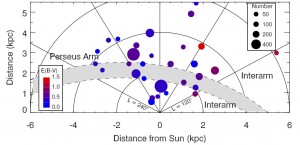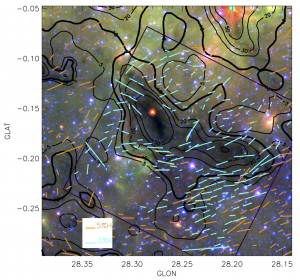How NIR polarimetry tells us about the Magnetic Field
Dust grains in the interstellar medium and in molecular clouds are aspherical and can get spun up by an illuminating source. When they do, these grains become aligned with their long axes perpendicular to the intervening magnetic field. Because of this, background starlight is preferentially extincted along the long axes of these dust grains, and picks up a small polarization signal (of order a few percent) in the direction of the magnetic field. Therefore, the directions of the polarizations of these stars trace the orientation of the magnetic field in the plane of the sky.
The Magnetic Field of IRDCs
IRDCs are dense, filamentary molecular clouds that host massive star formation. Using deep NIR polarimetry, I study the interaction between a sample of these clouds and their magnetic fields. One cloud in the sample is G28.23, which is a massive, starless, IRDC. The polarization observations for this cloud consist of shallow H-band (1.6 μm) observations from GPIPS and deeper K-band (2.2 μm) observations. Interestingly, the polarizations, which trace the plane-of-sky magnetic field orientation, appear to curve around the IRDC.
The Large-Scale Magnetic Field in the Outer Galaxy
 To probe the magnetic field in the outer Galaxy, I use the polarization measurements of stars found in a sample of 31 open star clusters. Star clusters are particularly useful probes of the magnetic field because we can get estimate their distances, which provides an upper limit to the distance of the magnetic field being probed. To use the polarization observations of these clusters, I found their distances by using a reduced Χ² method to fit theoretical stellar isochrones to the cluster color-magnitude diagrams. The clusters span a wide range in Galactic longitude and are interspersed behind and in front of the Perseus Spiral Arm.
To probe the magnetic field in the outer Galaxy, I use the polarization measurements of stars found in a sample of 31 open star clusters. Star clusters are particularly useful probes of the magnetic field because we can get estimate their distances, which provides an upper limit to the distance of the magnetic field being probed. To use the polarization observations of these clusters, I found their distances by using a reduced Χ² method to fit theoretical stellar isochrones to the cluster color-magnitude diagrams. The clusters span a wide range in Galactic longitude and are interspersed behind and in front of the Perseus Spiral Arm.
Chemical Evolution of High-Mass Star-Forming Regions
In addition to NIR polarimetry, I also studied the chemical evolution of high-mass star-forming regions in the Galactic plane with Prof. James Jackson and the MALT90 team. The goal of the study was to determine whether the relative abundances of certain molecules changed as a function of star formation evolution. I looked at the spectra of five molecules with transitions near 90 GHz for a sample of ~350 massive star-forming regions ranging from prestellar to protostellar to HII regions, and found that the molecular abundances broadly changed as a function of evolution.
Properties of Star Clusters
As an undergraduate, I studied the properties of a sample of open star clusters with Prof. Ken Janes. Using optical photometric data, we found cluster extents, ages, distances, reddenings, and number of cluster members for several clusters.
